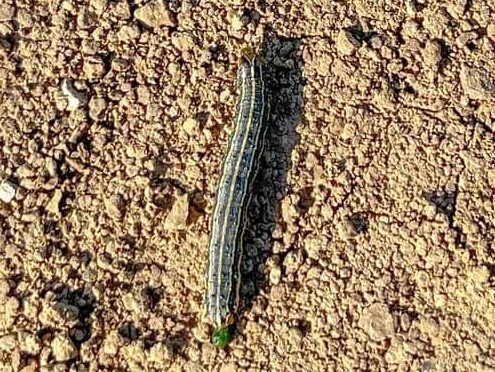Armyworm Pest Alert

Worms, worms and more worms? Fall is a busy time of the year for farm families with wheat drilling and fall harvest. One of your tasks might be to scout fields for pests that could cause potential damage to growing crops or crops that you will be seeding this fall.
If you have seen several different kinds of worms this fall, you are not alone. According to K-State Research and Extension Entomologist Dr. Jeff Whitworth, 2021 might be called the year of the worm. The first thing to do is to determine which worm is present. Proper identification is important because they have different feeding and overwintering patterns.
Starting in late winter and early spring 2021, there was considerable activity by army cutworms. Most of the problem was caused by the larvae really attacking thin stands of wheat and alfalfa. Army cutworms spend the summer in the Rocky Mountains but start to migrate back into Kansas in early fall every year. The larvae may feed on just about any plants, but mostly affect wheat and alfalfa, as these are usually the only plants actively growing this time of year.
Then, since late spring and early summer, a combination of armyworms and fall armyworms have been causing serious concern and damage in lawns, pastures and alfalfa fields throughout about the eastern two-thirds of the state.
Whitworth points out that armyworms, probably more so than fall armyworms, may continue to cycle through another generation or even two as they overwinter in Kansas, and thus it will probably take a hard frost or freeze to stop them. Armyworms infest primarily grasses, such as sorghum, corn, brome pastures, lawns and often this time of year, wheat, but occasionally alfalfa. So, if armyworms are the problem they could be around through another generation or maybe even two depending upon the weather. If armyworms are relatively small, a quarter to a half-inch, they will probably feed for another 10 to 14 days then pupate or stop feeding. If they are relatively large, one to one and a half inches, they will probably pupate in the next three to seven days. There will probably be at least one more generation of armyworms.
Fall armyworms, since they don't usually overwinter in Kansas, may migrate south after this generation become adults, but there could be another or at least a partial generation. Whitworth points out that it has a very identifiable inverted Y on the head. It usually arrives in Kansas in July where it lays eggs on corn, sorghum and other summer crops. Several generations occur and reproduction may continue through August and into September and even sometimes into October depending on the weather, putting early-planted wheat at greatest risk. Early-planted fields should be inspected frequently during the first few weeks following emergence.
As with their name, armyworms, they tend to start on one side of a field and move in a group across the field like an army. So you may find that pattern in your field.
Whitworth stresses when scouting fields for fall armyworm damage, look for windowpane injury caused by tiny larvae chewing on seedling leaves. Each individual field should be scouted in several locations, including the field margins and the interior. The larvae themselves are usually too small to be easily observed after they first hatch, and hide in or around the base of seedlings. There are probably all sizes out in the fields from pretty small and about the same color as the soil, so they are fairly difficult to spot at first. After a few days, the worms grow larger and become darker in color with a distinct stripe, sometimes yellow, down one side. Within a few days of hatching, the larvae become large enough to destroy entire leaves.
Fall armyworms have a little wider host range, which includes alfalfa, soybeans, corn, sorghum or wheat, but don't usually overwinter in Kansas, thus, hopefully, will be heading south after these larvae finish feeding and become moths.
According to Whitworth, the suggested treatment threshold is two to three actively feeding larvae per linear foot of row in wheat. Fields with 25 to 30 percent of plants with windowpane injury should be re-examined daily and treated immediately if stand establishment appears threatened. Larvae increase in size at an exponential rate, and so do their food requirements. Later instars do the most damage, sometimes destroying entire stands, and are the least susceptible to insecticides. Without treatment, problems can continue until larvae reach maturity or until a killing frost. Thin stands of wheat are especially at risk. Fall armyworms will feed until the temperatures cool into the mid-20s or they pupate, whichever comes first. If a killing frost does not occur soon after the treatment threshold is reached, fields may require chemical treatment.
The army cutworm may be coming later, as mentioned earlier, as it is a late fall and winter to early spring pest of wheat. So, in the next 30 to 60 days, army cutworm moths should have returned from their summer Rocky Mountain retreats to deposit eggs throughout at least the western two-thirds of the state and thus, these tiny worms will start feeding on wheat and alfalfa all winter. The larvae begin feeding during winter when the temperatures rise a few degrees above freezing. Infestations in well-established stands will probably not require insecticide applications while wheat is dormant. But some fields may not green up in the spring, because of cutworm feeding in the fall and winter.
Contact Midway Extension District Crop Production Agent Craig Dinkel at 785-472-4442 with any questions regarding this pest.
(Information and photo courtesy Post Rock Extension District.)

